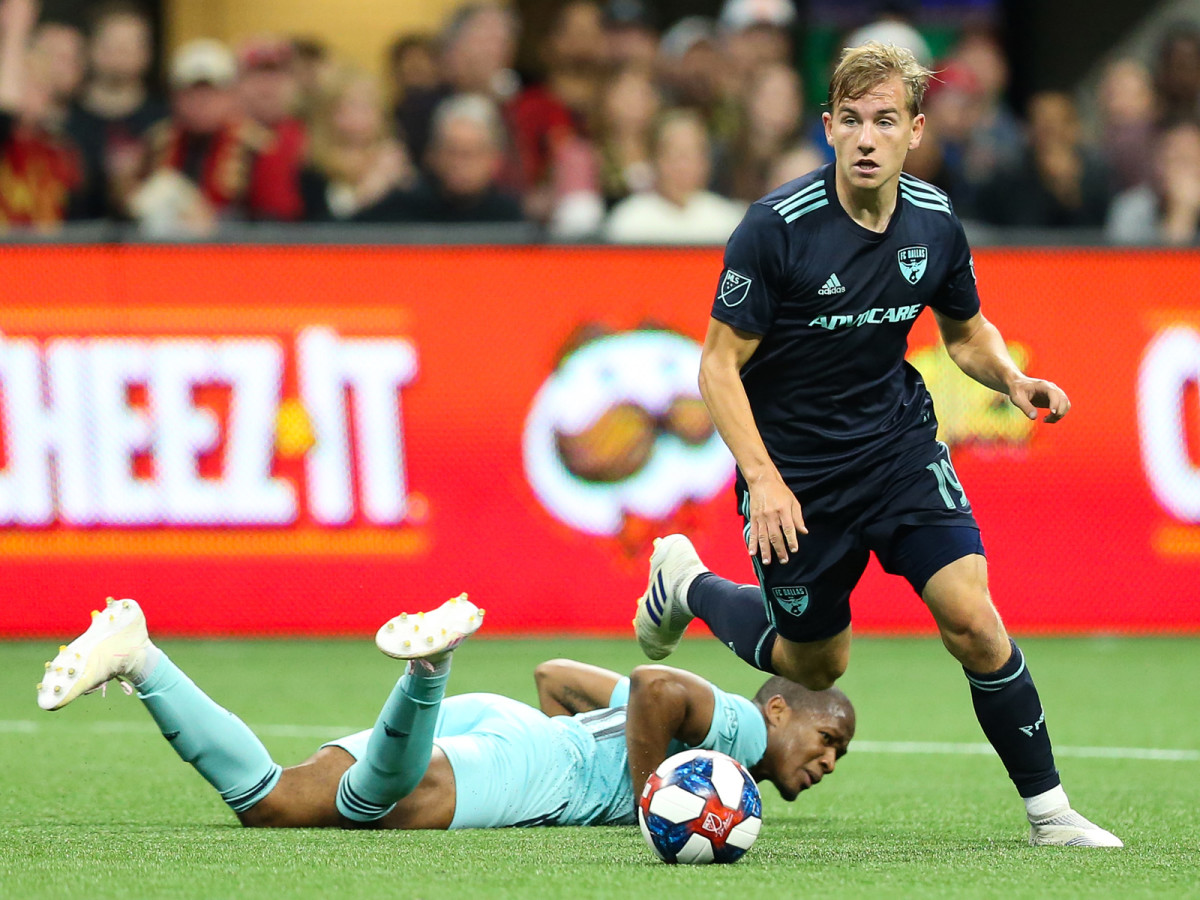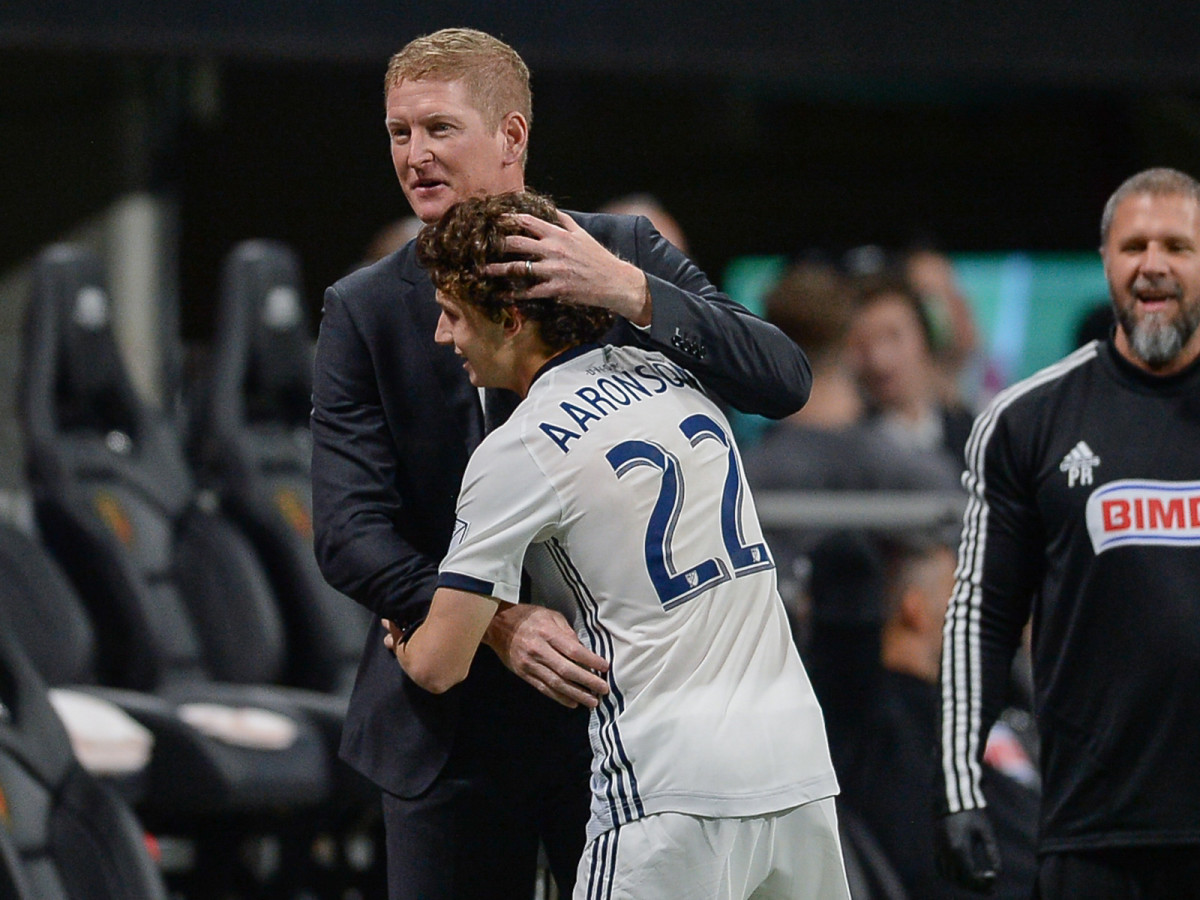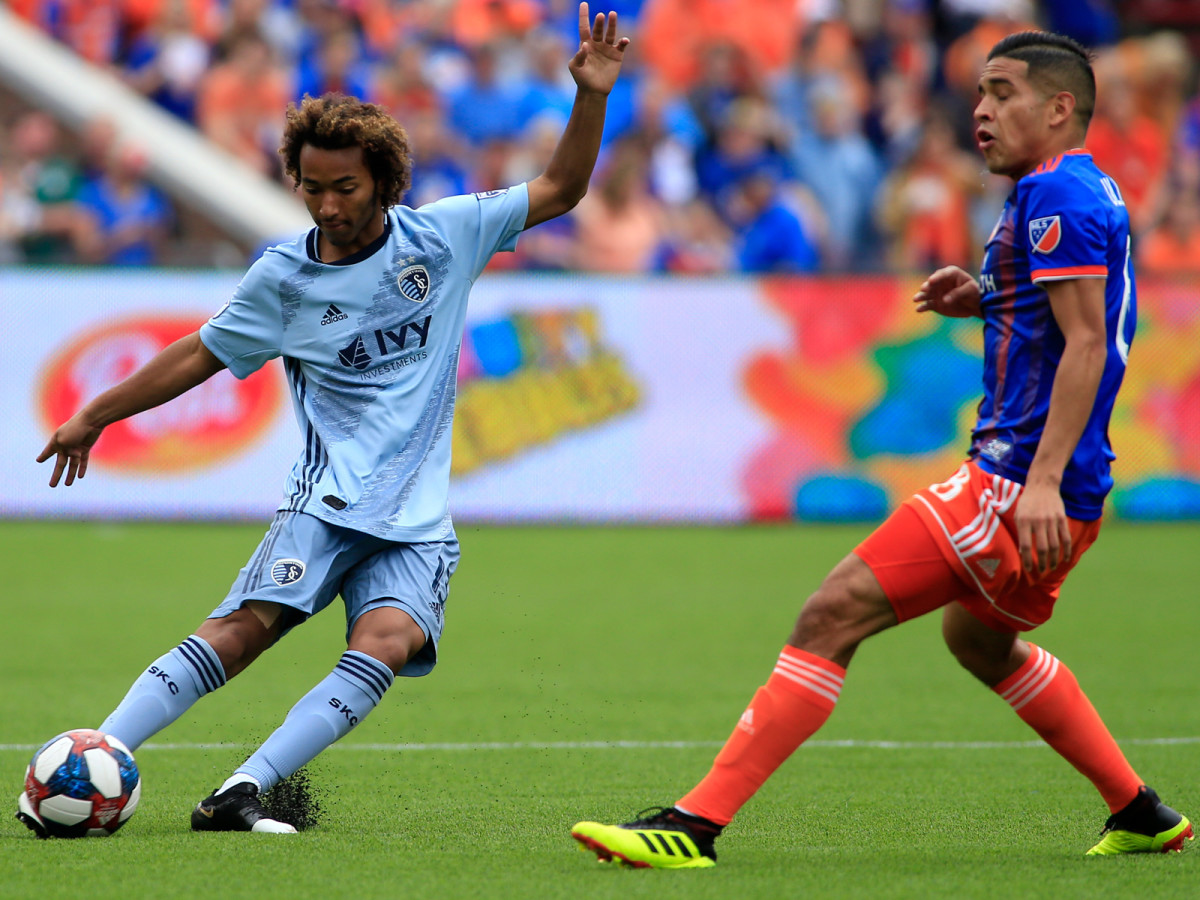The Rise of MLS's Young, American Attacking Midfielders

Imagine being a teenager and walking onto a soccer field. In the opposing line strides your league’s defending champions, including the reigning MVP and the most expensive player in league history. Some 42,000 screaming fans form a sea of red and black.
You’d be pretty nervous. The Philadelphia Union's 18-year-old attacking midfielder Brenden Aaronson certainly was.
“I was so nervous, my brain felt like it wasn’t working to be honest,” he said.
Then the whistle blows, and the crowd, noise, bright lights, and accolades of his opponents fade into the background.
At that point it doesn’t matter what Atlanta United had won, how many goals Josef Martinez had scored or how many millions of dollars were spent on Pity Martinez. And it doesn’t matter that Aaronson is the youngest player on the field.
And none of it mattered when, in the 47th minute, Aaronson fired a shot past Brad Guzan to give Philadelphia the lead on his first goal in MLS.
It’s a spectacular moment, but it’s something that has been able to become a more frequent occurrence in 2019 for players like him.
Young Americans playing important roles for their clubs isn’t a particularly new trend. What is new, though, is where on the field those young Americans play. The majority of American players who have developed in MLS and its academies and gone on to play at the international level or in Europe have been more defensive than creative. Recent examples include defenders like DeAndre Yedlin, Matt Miazga and Chris Richards, or more defensive-minded midfielders like Tyler Adams and Wil Trapp. The MLS goalkeeping pipeline to the national team has long been in place.
Part of this has to do with the roster structure of MLS. The three allotted Designated Player spots on each club's roster are typically used for attacking players, meaning less opportunity for young players to break into teams in attacking positions. That is starting to change, though. Sporting Kansas City's Gianluca Busio, who turns 17 next week, has benefited from an injury to midfielder Roger Espinoza. Aaronson has flourished thanks to injury and suspension incurred by Marco Fabian. Such circumstances may be what was required for young American creative players to be given the same trust by their coaches that has been afforded to more defensive-minded players for years.
“Historically we’re able to produce good honest center backs, good honest outside backs, or a good holding midfielder,” Union manager Jim Curtin said. “This year more than ever coaches have given opportunity to young, American attacking players and they’re not disappointing. It’s no secret, that’s what clubs in Europe want to buy: players that influence and get goals.”
That was evident by Bayern Munich shelling out an MLS-record fee for Vancouver Whitecaps product Alphonso Davies in the fall, and as more young talents get the chance to shine, those kinds of transactions figure to become more of the norm.
Busio, for instance, is just one of several teenage American midfielders opening eyes in MLS. He put himself on the map by scoring in three consecutive games for Sporting Kansas City, but he never expected to find himself in MLS so quickly. Neither did head coach Peter Vermes, who has seen plenty of young players come through the ranks in more than a decade at the helm of SKC but perhaps none with such maturity beyond his years.
“At the start of the 2018 season we had a plan for him,” Vermes said. “Honestly, we had to take that plan and tear it up, because he completely outpaced what that plan was going to be. He blew our expectations away.”
For Vermes, Busio proved himself worthy of the opportunities he’s been given. But beyond players proving their worth, he says teams must set young players up for success and create an environment where they won’t feel as if they have to carry the team on their shoulders.
The gold standard on that front is FC Dallas, home to one of the league’s top academies and 19-year-old Paxton Pomykal, it’s most recent homegrown success story in a long line of them.
Pomykal doesn’t view being the latest poster boy for an academy that also included Schalke's Weston McKennie and Bayern Munich's Richards–even though they didn't play for the first team before leaving for Germany–as a source of pressure, but rather as motivation and reassurance.
“I think if anything there’s less pressure, because we see all the success that guys like Kellyn [Acosta] and Victor [Ulloa] have had,” Pomykal said. “It makes it less stressful than for someone at a team like LA Galaxy where they don’t really have that model guy that’s really done it.”
Not every homegrown player Dallas has given MLS minutes to has panned out long-term, but head coach and former academy director Luchi Gonzalez is adamant that players have to be allowed to make mistakes and be given the chance to work through them.
“[Pomykal has] had to show the patience and grit required to go from the academy to the first team,” Gonzalez said. “As long as he’s working hard and showing those characteristics, he’s going to play.”
FC Dallas's abundance of homegrown players over the years is a credit to Gonzalez’s unique philosophy of not letting wins and losses dictate his decision making.
“Development is No. 1,” he said. “I know I’m hired to earn points and win the Cup, but I feel the best way to do that is with the fundamental of development.”

It’s an approach MLS would like to see more teams take. A greater focus on player development was one of the league’s points of emphasis in offseason meetings with team officials before this season.
“Our view is the only way we are going to be able to achieve the highest level of product and player quality that we endeavor to achieve is to do so by continuing to invest and develop players,” said Todd Durbin, MLS's vice president of competition and player relations.
Better youth players make up one avenue for improving the talent of a team, with the other being obvious: buy it. That’s not always easy for MLS clubs given the strict financial structure and limitations on both international players and Designated Players and the varying level of willingness to spend big across the league's different ownership groups. MLS has increased the cap on targeted allocation money (TAM) available for teams to spend, which Durbin says has had a knock-on effect of increasing the competition among young players for MLS minutes.
“It pushes everything forward,” Durbin said. “In order to make the academy you have to be better. In order to make the team you have to be better. In order to play you have to be better.”
For FC Dallas, which won both the Supporters' Shield and U.S. Open Cup in 2016, the practice of moving players straight from the academy into MLS is a regular one, but even FCD has adjusted to the newer way of doing things.
Out of 24 MLS teams, 12 now have affiliates in the United Soccer League (several others have official affiliates that are independent teams), which allow them to build a structure not unlike the minor league systems of professional baseball. For FC Dallas, its partnership with North Texas SC is in its first year and gives the club's abundance of youth talent a place to further hone its skills in game situations.
Such partnerships have helped fuel the USL’s continuous expansion boom, with its three divisions now including 116 teams (72 are in USL League Two) and counting.
Few MLS teams have benefited from the arrangement as much as the Philadelphia Union. All six homegrown players on the club's current roster gained experience playing for USL Championship outfit Bethlehem Steel FC. Last year, Curtin drew attention for starting two teenage center backs: Auston Trusty and Mark McKenzie, the latter of whom will captain a U.S. Under-20 men's national team that includes Pomykal at the FIFA U-20 World Cup that kicked off this week in Poland.
This season, the attention has been at the attacking end of the field. Aaronson stepped into the spotlight by scoring that goal in Atlanta. He's gone on to start nine of the Union's 10 games since, and he’s played well for a Philadelphia team that currently sits on top of the Eastern Conference. Busio and Pomykal have been fixtures for their teams as well, rather than just being given bit parts in deference to older, more experienced players.
“I think coaches need to be brave enough to put them out there, and not just when you’re up 3-0 or down 3-0,” said Curtin, who has worked with Aaronson since he was 9. “It has to be for 90 minutes and for a stretch of real games. Brenden’s on a run where he’s getting huge chunks of minutes, and that’s the only way they’re going to get better.”

MLS only recently has become comfortable with the idea of being a “selling league,” a recognition of the profits to be made by developing young players and selling them. From the league’s point of view, the potential financial incentives should be all the convincing clubs need to give more opportunities to young attacking players. That said, it is not going to set any sort of quota for the numbers of Americans or players under a certain age that teams have to field.
“We don’t want to mandate or tell teams how to run their organizations,” Durbin said. “It’s not for the league to turn around and say, ‘This is the way to do it.’”
Most MLS teams seem to be on board with the idea, as 16 teams–two-thirds of the league–have played teenagers at some point this season.
The financial benefit doesn’t just come from the potential sale of promising young players. If homegrown attackers succeed, then teams don’t have to spend big money on foreign attacking talent.
“If you’re an MLS team and you’re investing millions of dollars in your academy, you want your players, your investment, to come to the first team,” said U.S. U-20 men's national team coach Tab Ramos. “That’s saving you money on buying players from somewhere else. There’s a return on the investment, and I think that’s part of the reason.”
Whatever reason for the emergence of players like Pomykal, Busio and Aaronson, Ramos isn’t complaining. He stands to benefit as much as anyone.
For the first time, the U.S. U-20 World Cup roster includes no collegiate players, in part due to the quality of talent being produced in MLS academies and the continued shift away from college soccer as the preferred path to the pros for American players.
Ramos, who made 81 appearances for the U.S. between 1988 and 2000 and took part in three World Cups, has been in charge of the U-20s since 2011. From his perspective, the best thing for the success of his teams is for his players to have as much professional experience as possible.
“Players are now fighting for time on their first teams, which is a great place to be and where we wanted to be back when we all started complaining about ‘why don’t young players play more?’” Ramos said. “It’s clear we’re heading in the right direction.”
MLS often plays through FIFA international windows, meaning that accepting youth national team opportunities may come at the cost of first-team MLS games. In most cases, the decision isn’t given a second thought, though.
“I don’t want to jeopardize those opportunities for him,” Vermes said of Busio, who took full advantage of his inclusion in the roster for the recent U-17 Concacaf Championship. He scored five goals and added three assists, as the U.S. finished second to Mexico and qualified for this fall’s FIFA U-17 World Cup.

Playing for youth national teams also levels the playing field physically and allows these players to showcase the full extent of their skills. MLS is a physical league and can be daunting for lighter-weights like Aaronson, Busio and Pomykal.
What they may lack in size, they make up for maturity and high soccer IQ, with all three regularly wriggling away from challenges by substantially larger opponents, their slightness allowing them to be quicker than most defenders.
Aside from the physical challenges that come with being a teenager in MLS, there comes adjusting to a locker room where some teammates are twice their age. More impressive than their play on the field may be the maturity required for these players to thrive in such an environment.
“We have to remind ourselves sometimes that he’s only 16 because he fits in so well,” Vermes said of Busio. “He’s in the locker room with guys that are 30 years old and have their second or third kid. He’s just getting his driver’s license.”
Perhaps the most notable indicator of success for these young men is how normal it seems and the sense they exude that they belong–and with that has come a friendly sense of competition.
“We see our friends succeeding in the league and we want to do well,” Pomykal said. “To see guys like Gianluca and Brenden doing the same around the league, they’re not giving their coaches a reason to take them out.”
Added Busio: “At some point it was bound to happen. We have a lot of talented young Americans coming up right now, and I think it was just a matter of time before [we] really made our mark in MLS.”
